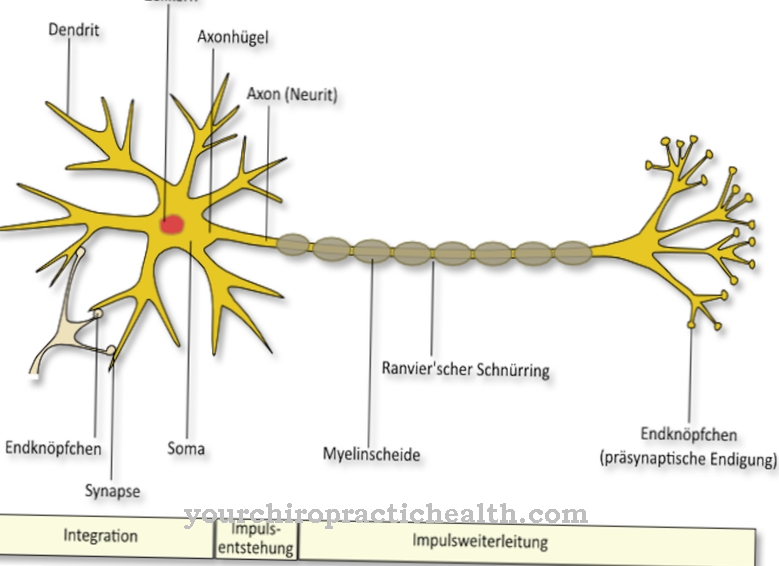The Renal pelvis are part of the urinary tract. They collect the urine from the kidneys and form the transition to the ureters. The urine flows through this into the urinary bladder.
What is the renal pelvis?
The renal pelvis (pelvis renalis) is a round to funnel-shaped sac that connects the kidney and bladder. It is the collection point for the terminal urine, which contains the waste substances from the blood: the kidneys filter pollutants, decomposition products of drugs and other end products of the metabolism from the blood and thus clean it.
The terminal urine flows through tubular processes, the calyxes, into the renal pelvis. This tapers to the ureter, through which the urine flows into the bladder. This is where the urine collects until it is excreted through the urethra.
Experts refer to the renal pelvis and calyx system that passes urine to the ureters as the renal pelvic calyx system (NBKS). The renal pelvis is part of the kidneys, but together with the ureters, bladder and urethra form the urinary tract.
Anatomy & structure
The renal pelvis is located within the kidneys, surrounded by the renal medulla. Towards the bladder they narrow to the ureters. Towards the renal medulla, they expand in the shape of a funnel to form the so-called kidney calyxes, whereby this calyx system can look different: In the ampullary type, around eight to ten short kidney calyxes branch out from the renal pelvis.
In the dendritic type, on the other hand, the renal pelvis initially merges into two larger calyxes, which in turn divide into eight to ten shorter calyxes. This makes the structure look like a tree. The calyxes enclose the renal papillae - the tips of the pyramidal renal medulla. There are collecting tubes into each of which about ten kidney tubules open. Each of these tubules turns into a capsule that encloses a tangle of vessels, the so-called glomerulus.
The encapsulated blood vessels are also called kidney corpuscles. Together, kidney tubules and corpuscles form what are known as nephrons. About 1.4 million of these small filters are located in the kidney cortex, which surrounds the renal medulla and thus forms the outermost part of the kidney.
Function & tasks
The renal pelvis serves as a collection container for the terminal urine that the kidney tissue produces. The muscle cords in the renal pelvis and in the kidney calyxes contract rhythmically for this purpose: the urine is continuously pressed out of the calyxes and fed into the ureter.
From there the urine flows into the bladder. If it is full, it reports this in the form of an urge to urinate. The emptying can be controlled consciously. The urine is produced by the nephrons. To do this, the entire blood volume flows through the kidneys around 300 times a day - this corresponds to almost 1,500 liters. The nephrons hold back proteins and blood cells, while water, glucose, minerals as well as dissolved end products and breakdown products flow into the urinary canals.
Over 99 percent of the so-called primary urine, including mainly glucose and minerals, get back into the blood through the wall of the tubules. This process is called reabsorption and prevents the body from drying out and losing all essential salts and minerals. The rest of the filtrate, the so-called end urine, consists mainly of degradation substances and water.
It reaches the renal medulla via the urinary tubules and from there via the renal papillae into the calyx and the renal pelvis. This can absorb around six to ten milliliters of urine and is part of the body's own sewage treatment plant. Overall, the body produces up to two liters of urine per day.
Illnesses & ailments
The most common disease of the renal pelvis is inflammation of the kidney. It usually develops from a bacterial infection of the bladder: The bacteria multiply and rise through the ureter into the renal pelvis. Symptoms are flank pain and fever, and many patients also complain of difficulty urinating.
Kidney stones, diabetes, insufficient fluid intake and malformations of the urinary tract increase the risk. Discomfort can also be triggered by kidney stones. They occur when substances that are normally found dissolved in the urine - such as calcium or uric acid - are present in too large quantities. Then these substances can crystallize out. Stones are often the result of an unhealthy diet. Especially those who eat too much protein, drink too little or consume too much coffee and alcohol increase their risk.
Most of the stones come off by themselves with the urine. However, if the pain is severe, the stone may be too big and get stuck. Then doctors can remove it with medication or smash it with sound waves. Very rarely, stones in the ureters can cause the renal pelvis to tear (fornix rupture). Urine can then leak into the surrounding tissue, which is why a specialist should treat the tear immediately.
Renal pelvic carcinomas are also extremely rare: This type of cancer occurs mainly in men over 50 years of age. Smoking is considered an additional risk factor. Cancer of the renal pelvis can be easily diagnosed using ultrasound or CT, but symptoms such as blood in the urine or kidney pain usually appear late.
























.jpg)



